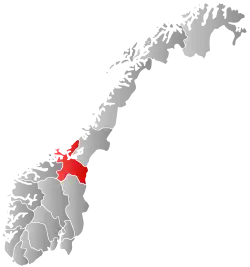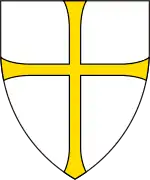Jøssund (municipality)
Jøssund is a former municipality in the old Sør-Trøndelag county, Norway. The municipality existed from 1896 until its dissolution in 1964. The 79-square-kilometre (31 sq mi) municipality encompassed northern coastal area of the present-day municipality of Ørland in Trøndelag county. The main church for Jøssund was Jøssund Church in the village of Jøssund which was the administrative centre of the municipality. Other villages in Jøssund included Lysøysundet and Vallersund.[1]
Jøssund herred | |
|---|---|
 Sør-Trøndelag within Norway | |
 Jøssund within Sør-Trøndelag | |
| Coordinates: 63°50′44″N 09°47′40″E | |
| Country | Norway |
| County | Sør-Trøndelag |
| District | Fosen |
| Established | 1 Jan 1896 |
| • Preceded by | Aafjord Municipality |
| Disestablished | 1 Jan 1964 |
| • Succeeded by | Bjugn Municipality |
| Administrative centre | Jøssund |
| Area (upon dissolution) | |
| • Total | 79 km2 (31 sq mi) |
| Population (1964) | |
| • Total | 1,917 |
| • Density | 24/km2 (63/sq mi) |
| Time zone | UTC+01:00 (CET) |
| • Summer (DST) | UTC+02:00 (CEST) |
| ISO 3166 code | NO-1629 |
History

The municipality of Jøssund was established on 1 January 1896 when it was split off from the large municipality of Aafjord. Initially, Jøssund had a population of 1,529.[2]
During the 1960s, there were many municipal mergers across Norway due to the work of the Schei Committee. On 1 January 1964, the municipality of Jøssund (population: 1,917) was merged with the neighboring municipalities of Bjugn (population: 1,240), Nes (population: 1,107), and the northern part of Stjørna (population: 676) to form a new, larger municipality of Bjugn.[2]
Name
The municipality (originally the parish) is named after the old Jøssund farm (Old Norse: Mjórsund). The first element comes from the word mjór which means "narrow" or "thin". The old name did originally start with an "m", but over time the initial letter disappeared from the spelling and pronunciation (sometime before the early 16th century). The last element is sund which means "sound" or "strait". Historically, the name's spelling has varied. In the 1500s and 1600s it was spelled Jußund using the letter ß, and by the 1700s, it was written in its current form.[3]
Government
While it existed, this municipality was responsible for primary education (through 10th grade), outpatient health services, senior citizen services, unemployment, social services, zoning, economic development, and municipal roads. During its existence, this municipality was governed by a municipal council of elected representatives, which in turn elected a mayor.[4]
Mayors
Municipal council
The municipal council (Herredsstyre) of Jøssund was made up of 17 representatives that were elected to four year terms. The party breakdown of the final municipal council was as follows:
| Party Name (in Norwegian) | Number of representatives | |
|---|---|---|
| Labour Party (Arbeiderpartiet) | 9 | |
| Christian Democratic Party (Kristelig Folkeparti) | 2 | |
| Joint List(s) of Non-Socialist Parties (Borgerlige Felleslister) | 6 | |
| Total number of members: | 17 | |
| Party Name (in Norwegian) | Number of representatives | |
|---|---|---|
| Labour Party (Arbeiderpartiet) | 10 | |
| Christian Democratic Party (Kristelig Folkeparti) | 2 | |
| Joint List(s) of Non-Socialist Parties (Borgerlige Felleslister) | 5 | |
| Total number of members: | 17 | |
| Party Name (in Norwegian) | Number of representatives | |
|---|---|---|
| Labour Party (Arbeiderpartiet) | 9 | |
| Christian Democratic Party (Kristelig Folkeparti) | 3 | |
| Local List(s) (Lokale lister) | 4 | |
| Total number of members: | 16 | |
| Party Name (in Norwegian) | Number of representatives | |
|---|---|---|
| Labour Party (Arbeiderpartiet) | 9 | |
| Christian Democratic Party (Kristelig Folkeparti) | 2 | |
| Joint List(s) of Non-Socialist Parties (Borgerlige Felleslister) | 5 | |
| Total number of members: | 16 | |
| Party Name (in Norwegian) | Number of representatives | |
|---|---|---|
| Labour Party (Arbeiderpartiet) | 10 | |
| Joint List(s) of Non-Socialist Parties (Borgerlige Felleslister) | 6 | |
| Total number of members: | 16 | |
| Party Name (in Norwegian) | Number of representatives | |
|---|---|---|
| Labour Party (Arbeiderpartiet) | 6 | |
| Joint List(s) of Non-Socialist Parties (Borgerlige Felleslister) | 10 | |
| Total number of members: | 16 | |
| Note: Due to the German occupation of Norway during World War II, no elections were held for new municipal councils until after the war ended in 1945. | ||
References
- Haugen, Morten, ed. (28 November 2014). "Jøssund – tidligere kommune". Store norske leksikon (in Norwegian). Kunnskapsforlaget. Retrieved 28 February 2018.
- Jukvam, Dag (1999). Historisk oversikt over endringer i kommune- og fylkesinndelingen (PDF) (in Norwegian). Statistisk sentralbyrå. ISBN 9788253746845.
- Rygh, Oluf (1901). Norske gaardnavne: Søndre Trondhjems amt (in Norwegian) (14 ed.). Kristiania, Norge: W. C. Fabritius & sønners bogtrikkeri. p. 27.
- Hansen, Tore; Vabo, Signy Irene, eds. (20 September 2022). "kommunestyre". Store norske leksikon (in Norwegian). Kunnskapsforlaget. Retrieved 1 January 2023.
- Olden, Arne L. (1957). "Jøssund". In Fiskaa, Haakon M; Myckland, Haakon Falck (eds.). Norges bebyggelse: Nordlige seksjon: Herredsbindet for Sør-Trøndelag: Nordre del (in Norwegian). Oslo: Norsk faglitteratur. p. 173.
- Sæther, Stein Arne, ed. (1993). Fosen. Natur, kultur og mennesker (in Norwegian). Trondheim: Adresseavisens Forlag. pp. 215–216.
- "Kommunevalgene og Ordførervalgene 1959" (PDF) (in Norwegian). Oslo: Statistisk sentralbyrå. 1960. Retrieved 14 April 2020.
- "Kommunevalgene og Ordførervalgene 1955" (PDF) (in Norwegian). Oslo: Statistisk sentralbyrå. 1957. Retrieved 14 April 2020.
- "Kommunevalgene og Ordførervalgene 1951" (PDF) (in Norwegian). Oslo: Statistisk sentralbyrå. 1952. Retrieved 14 April 2020.
- "Kommunevalgene og Ordførervalgene 1947" (PDF) (in Norwegian). Oslo: Statistisk sentralbyrå. 1948. Retrieved 14 April 2020.
- "Kommunevalgene og Ordførervalgene 1945" (PDF) (in Norwegian). Oslo: Statistisk sentralbyrå. 1947. Retrieved 14 April 2020.
- "Kommunevalgene og Ordførervalgene 1937" (PDF) (in Norwegian). Oslo: Statistisk sentralbyrå. 1938. Retrieved 14 April 2020.

